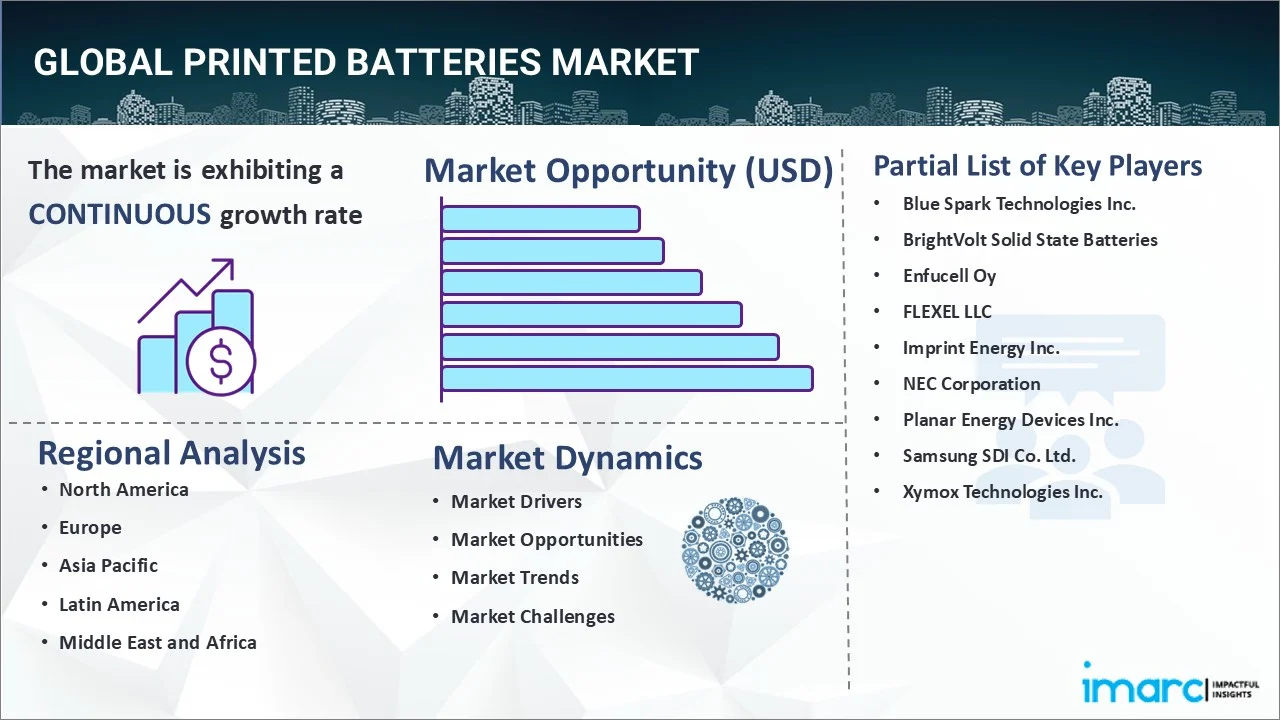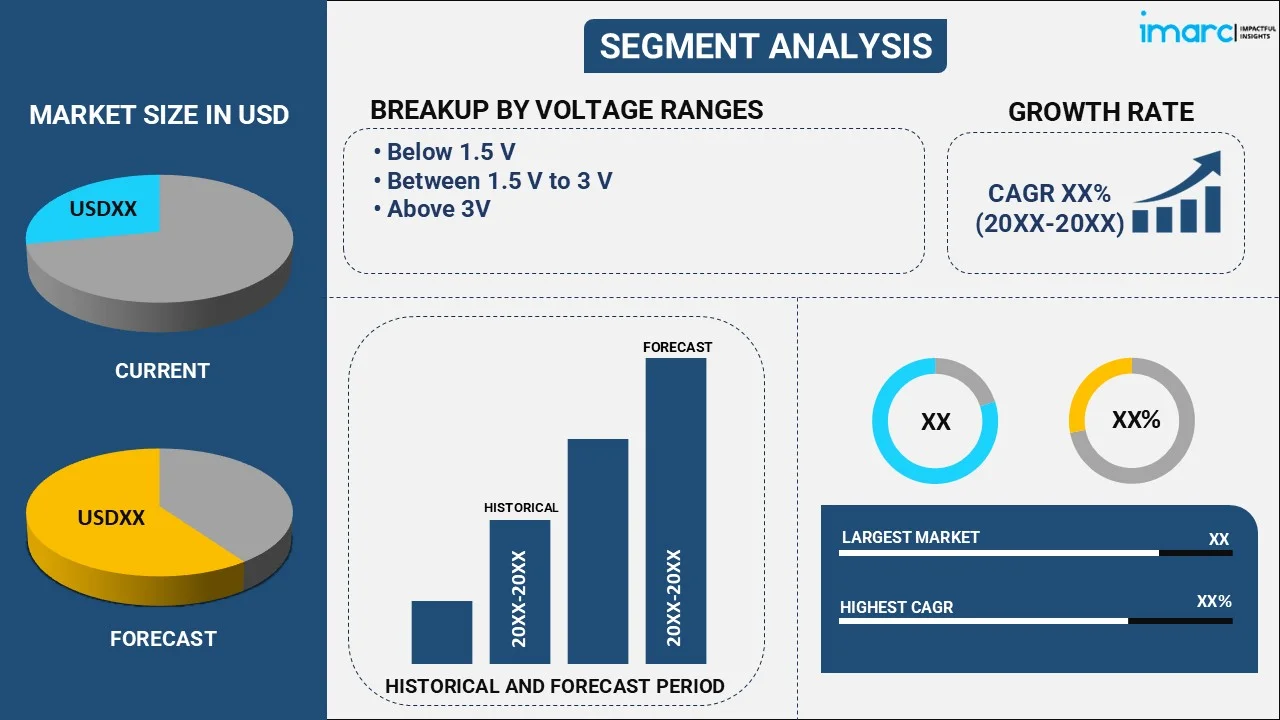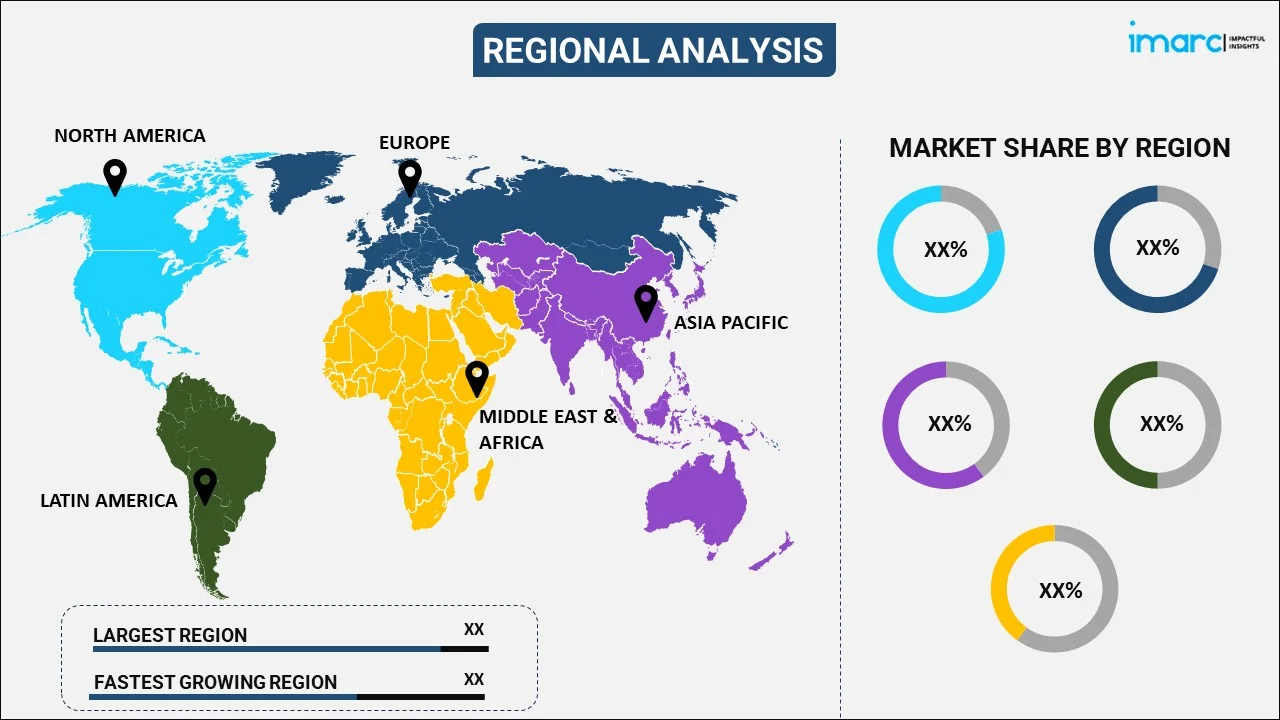
Printed Batteries Market Report by Voltage Range (Below 1.5 V, Between 1.5 V to 3 V, Above 3V), Product Type (Rechargeable, Non-Rechargeable), Application (Consumer Electronics, Energy Harvesting, Medical Devices, Smart Packaging, Smart Cards, Wearable Technology, and Others), and Region 2025-2033
Market Overview:
The global printed batteries market size reached USD 382.4 Million in 2024. Looking forward, IMARC Group expects the market to reach USD 6,631.8 Million by 2033, exhibiting a growth rate (CAGR) of 35.44% during 2025-2033. The supportive government initiatives and funding for research and development, the increasing demand for portable and on-the-go power solutions, and the rising product applications in automotive electronics and electric vehicles are some of the factors propelling the market.
|
Report Attribute
|
Key Statistics
|
|---|---|
|
Base Year
|
2024 |
|
Forecast Years
|
2025-2033
|
|
Historical Years
|
2019-2024
|
| Market Size in 2024 | USD 382.4 Million |
| Market Forecast in 2033 | USD 6,631.8 Million |
| Market Growth Rate (2025-2033) | 35.44% |
Printed batteries are cutting-edge technology that involves fabricating batteries using printing techniques. These batteries are created by depositing conductive materials and active components onto various substrates using specialized printing processes like screen printing, inkjet printing, or roll-to-roll printing. This innovative approach allows for producing thin, flexible, and lightweight batteries with customizable shapes and sizes. These batteries hold significant promise for powering various electronic devices and wearable technologies due to their low-profile design and potential for integration into flexible surfaces. They also offer the advantage of cost-effectiveness and scalability, making large-scale production feasible. As research and development in this field continue to progress, printed batteries have the potential to revolutionize the electronics industry by enabling new applications and enhancing the efficiency and portability of electronic devices.

The global market is majorly driven by the increasing advancements in printing technology. In line with this, the rising demand for wearable electronics is significantly contributing to the market. Furthermore, the growing adoption of Internet of Things (IoT) devices is positively influencing the market. Apart from this, the expanding applications in medical devices and the rise in demand for flexible and thin batteries are catalyzing the market. Moreover, the cost-effectiveness and scalability of printed batteries offer numerous opportunities for the market. The enhanced energy density and performance of printed batteries are propelling its demand. Besides, the escalating environmental concerns are driving interest in sustainable power solutions. Additionally, the increasing product integration into smart packaging for product tracking and authentication is providing a boost to the market.
Printed Batteries Market Trends/Drivers:
Increasing demand for low-power electronic devices in remote areas
The increasing demand for low-power electronic devices in remote areas is favorably impacting the market. In remote regions, where access to traditional power sources may be limited or unreliable, low-power electronic devices play a crucial role in various applications. Printed batteries offer a practical and efficient solution for powering these devices due to their lightweight, flexible, and portable nature. Remote monitoring systems, wireless sensors, and communication devices used in environmental monitoring, agriculture, wildlife tracking, and disaster management often require long-lasting and self-sustaining power sources. Printed batteries can be seamlessly integrated into these devices, providing a reliable and autonomous power supply without frequent battery replacements or complex wiring. Their ability to deliver power to low-energy consumption electronics for extended periods is a game-changer for remote operations, enabling continuous data collection and communication. Moreover, the batteries' cost-effectiveness and ease of production make them attractive for mass deployment in remote areas, fostering economic viability and sustainable development. As the demand for remote applications grows, the market is expected to expand substantially, addressing critical power needs in these remote and challenging environments.
Rising integration with flexible displays and electronic textiles
The rising product integration with flexible displays and electronic textiles is bolstering the market. As electronic devices become more compact, lightweight, and wearable, there is a growing demand for power solutions that seamlessly conform to these flexible surfaces. These batteries offer a perfect match for these applications due to their inherent flexibility and ability to be shaped into various form factors. By integrating with flexible displays, such as bendable screens in smartphones, e-readers, and wearable devices, these batteries enhance portability and user experience while eliminating the need for bulky and rigid power sources. Furthermore, electronic textiles or e-textiles, where clothing and fabrics are embedded with electronic components, play a pivotal role. These batteries can be easily incorporated into the fabric without compromising comfort or aesthetics, providing a discreet and efficient power supply for wearable health monitors, smart clothing, and even military and communication gear. As the demand for flexible and wearable electronics continues to rise, the seamless integration of printed batteries with these innovative applications is expected to drive market growth and open up new possibilities for electronic devices that conform to the contours of daily lives.
Growing focus on miniaturization and lightweight electronics
The growing focus on miniaturization and lightweight electronics is fostering the market. As technology advances, there is an increasing demand for smaller, more portable electronic devices that offer high functionality without compromising performance. These batteries align perfectly with this trend as they can be fabricated in ultra-thin and lightweight forms, making them ideal power sources for miniaturized electronics. They can be designed to fit into the tiniest of spaces, enabling the creation of compact devices with reduced overall dimensions. Additionally, the lightweight nature of these batteries is particularly advantageous for wearable devices, portable gadgets, and handheld electronics. By shedding unnecessary weight and bulk associated with traditional battery technologies, these batteries enhance user comfort and convenience. Integrating printed batteries directly into electronic components further supports miniaturization efforts, streamlining the manufacturing process and reducing the device's overall size. With the electronics industry continuously pushing the boundaries of size and weight reduction, the market is expected to grow as a preferred power solution that complements the demand for miniaturization and lightweight electronics.
Printed Batteries Industry Segmentation:
IMARC Group provides an analysis of the key trends in each segment of the global printed batteries market report, along with forecasts at the global, regional and country levels from 2025-2033. Our report has categorized the market based on voltage range, product type and application.
Breakup by Voltage Range:

- Below 1.5 V
- Between 1.5 V to 3 V
- Above 3V
Below 1.5 V dominates the market
The report has provided a detailed breakup and analysis of the market based on the voltage range. This includes below 1.5 V, between 1.5 V to 3 V, and above 3V. According to the report, below 1.5 V represented the largest segment.
Batteries falling below the 1.5V category typically include button, coin, and rechargeable lithium-ion batteries. They are commonly used in small electronic devices such as watches, remote controls, hearing aids, and calculators. These low-voltage batteries are preferred for their compact size and ability to power devices with minimal power requirements.
Furthermore, 1.5 V to 3 V encompasses a wide range of batteries, including popular alkaline batteries and primary lithium batteries. These batteries find use in various electronic devices, such as digital cameras, portable radios, toys, and handheld gaming devices. They provide a moderate power level suitable for devices that demand more energy than those in the sub-1.5 V range.
Moreover, batteries with an output voltage above 3 V typically include lithium-based batteries, such as lithium-ion, lithium-polymer, and some specialty batteries. These high-voltage batteries are commonly used in more power-hungry devices such as laptops, smartphones, power tools, and other portable electronics that require substantial energy capacity.
Breakup by Product Type:
- Rechargeable
- Non-Rechargeable
Rechargeable holds the largest share of the market
A detailed breakup and analysis of the market based on the product type have also been provided in the report. This includes rechargeable and non-rechargeable. According to the report, rechargeable accounted for the largest market share.
Rechargeable batteries include batteries designed for multiple charge and discharge cycles. They are popular for their ability to be reused, reducing waste and long-term costs. Common rechargeable battery chemistries include lithium-ion (Li-ion), nickel-metal hydride (NiMH), and nickel-cadmium (NiCd). Rechargeable batteries find widespread use in portable electronics like smartphones, laptops, cameras, and electric vehicles. They are favored for their environmental friendliness and cost-effectiveness over time.
On the other hand, the non-rechargeable batteries are designed for single use only and cannot be recharged. Common non-rechargeable battery types include alkaline, zinc-carbon, and lithium primary batteries. They are often found in devices with low power consumption, such as remote controls, clocks, smoke detectors, and various disposable electronic gadgets.
Breakup by Application:
- Consumer Electronics
- Energy Harvesting
- Medical Devices
- Smart Packaging
- Smart Cards
- Wearable Technology
- Others
Smart cards holds the largest share of the market
A detailed breakup and analysis of the market based on the application have also been provided in the report. This includes consumer electronics, energy harvesting, medical devices, smart packaging, smart cards, wearable technology, and others. According to the report, smart cards accounted for the largest market share.
Smart cards, including contact and contactless payment cards, are the largest application type driving the growth of the market. Printed batteries provide a compact and efficient power source for smart cards, supporting their functionalities such as data storage and communication. As a result, the rising adoption of contactless payment, IoT integration, identity and access management, and transportation systems contribute to the demand for printed batteries in smart cards application.
Consumer electronics, on the other hand, encompasses a wide range of portable electronic devices used in daily life, such as smartphones, tablets, laptops, digital cameras, wearables, and gaming consoles. These devices rely on various types of batteries, including lithium-ion, lithium-polymer, and alkaline batteries, to power their functionalities efficiently and provide long-lasting energy for seamless user experiences.
Furthermore, energy harvesting involves using batteries with energy harvesting technologies, such as solar panels, piezoelectric systems, or thermoelectric generators. These batteries store the harvested energy for later use in wireless sensors, remote monitoring devices, and low-power electronics, reducing the dependence on traditional power sources and enabling self-sufficient and environmentally friendly solutions.
Moreover, batteries play a critical role in powering medical devices, from simple medical instruments like thermometers and blood glucose monitors to more advanced equipment such as pacemakers, defibrillators, and implantable medical devices. Reliability and long life are crucial in this segment, making rechargeable lithium-ion and primary lithium batteries commonly used to ensure medical devices' continuous and safe operation.
Breakup by Region:

- North America
- United States
- Canada
- Asia Pacific
- China
- Japan
- India
- South Korea
- Australia
- Indonesia
- Others
- Europe
- Germany
- France
- United Kingdom
- Italy
- Spain
- Russia
- Others
- Latin America
- Brazil
- Mexico
- Others
- Middle East and Africa
North America exhibits a clear dominance, accounting for the largest printed batteries market share
The report has also provided a comprehensive analysis of all the major regional markets, which include North America (the United States, Canada); Asia Pacific (China, Japan, India, South Korea, Australia, Indonesia, Russia, Others); Europe (Germany, France, the United Kingdom, Italy, Spain, Others); Latin America (Brazil, Mexico, Others); and the Middle East and Africa. According to the report, North America accounted the largest market segment.
The North American market is characterized by its technologically advanced economies, high disposable income, and a strong focus on sustainability and environmental regulations. In this region, there is a growing demand for batteries that support the rapid expansion of electric vehicles (EVs), renewable energy storage solutions, and smart grid applications. Additionally, consumer electronics, medical devices, and industrial sectors drive the need for high-performance batteries.
Furthermore, the Asia Pacific region is also a significant player in the market. The region's expanding electronics industry, coupled with the increasing adoption of electric vehicles and energy storage systems, fuels the product demand. The region also benefits from the presence of major battery manufacturers and suppliers and favorable government initiatives to promote green energy and electric mobility.
Competitive Landscape:
Top printed batteries companies are actively contributing to the market growth by harnessing innovative technologies and strategic initiatives. Through extensive research and development, these companies are pushing the boundaries of printed battery capabilities, enabling the creation of flexible and lightweight power sources. These firms are investing in cutting-edge materials and manufacturing processes, optimizing battery performance and reliability. They are collaborating with diverse industries to integrate printed batteries into a wide range of products, including wearables, medical devices, and Internet of Things (IoT) applications. Moreover, these companies are focused on scaling production capacities to meet the increasing demand for eco-friendly and cost-effective energy solutions. By adhering to sustainability practices and adhering to stringent quality standards, they instill consumer confidence and expand the market for printed batteries globally.
The report has provided a comprehensive analysis of the competitive landscape in the printed batteries market. Detailed profiles of all major companies have also been provided.
- Blue Spark Technologies Inc.
- BrightVolt Solid State Batteries
- Enfucell Oy
- FLEXEL LLC
- Imprint Energy Inc.
- NEC Corporation
- Planar Energy Devices Inc.
- Samsung SDI Co. Ltd.
- Xymox Technologies Inc.
Recent Developments:
- In 2020, BrightVolt announced a partnership with Bridgestone Corporation to collaborate on developing and commercializing next-generation solid-state batteries for various applications, including automotive and IoT devices. The collaboration aimed to leverage BrightVolt's expertise in solid-state battery technology and Bridgestone's capabilities in material science and manufacturing.
- In 2022, Imprint Energy launched its latest generation of zinc-based battery technology, called ZinCore. The battery offers improved portable power and is suitable for IoT product design and mobile connectivity. ZinCore batteries provide 10x more power in the same volume compared to previous zinc-based batteries and can withstand extreme temperatures. They are also thinner, more flexible, and customizable, making them suitable for various applications such as smart labels, medical devices, and IoT wearables.
- In 2023, Samsung SDI and Stellantis announced plans to build a second battery manufacturing facility in the United States under their joint venture, StarPlus Energy. The new plant is expected to start production in 2027 with an initial annual production capacity of 34 gigawatt hours (GWh).
Printed Batteries Market Report Scope:
| Report Features | Details |
|---|---|
| Base Year of the Analysis | 2024 |
| Historical Period | 2019-2024 |
| Forecast Period | 2025-2033 |
| Units | Million USD |
| Scope of the Report | Exploration of Historical and Forecast Trends, Industry Catalysts and Challenges, Segment-Wise Historical and Predictive Market Assessment:
|
| Voltage Ranges Covered | Below 1.5 V, Between 1.5 V to 3 V, Above 3V |
| Product Types Covered | Rechargeable, Non-rechargeable |
| Applications Covered | Consumer Electronics, Energy Harvesting, Medical Devices, Smart Packaging, Smart Cards, Wearable Technology, Others |
| Regions Covered | Asia Pacific, Europe, North America, Latin America, Middle East and Africa |
| Countries Covered | United States, Canada, Germany, France, United Kingdom, Italy, Spain, Russia, China, Japan, India, South Korea, Australia, Indonesia, Brazil, Mexico |
| Companies Covered | Blue Spark Technologies Inc., BrightVolt Solid State Batteries, Enfucell Oy, FLEXEL LLC, Imprint Energy Inc., NEC Corporation, Planar Energy Devices Inc., Samsung SDI Co. Ltd., Xymox Technologies Inc., etc. |
| Customization Scope | 10% Free Customization |
| Post-Sale Analyst Support | 10-12 Weeks |
| Delivery Format | PDF and Excel through Email (We can also provide the editable version of the report in PPT/Word format on special request) |
Key Benefits for Stakeholders:
- IMARC’s report offers a comprehensive quantitative analysis of various market segments, historical and current market trends, market forecasts, and dynamics of the printed batteries market from 2019-2033.
- The research study provides the latest information on the market drivers, challenges, and opportunities in the global printed batteries market.
- The study maps the leading, as well as the fastest-growing, regional markets. It further enables stakeholders to identify the key country-level markets within each region.
- Porter's five forces analysis assists stakeholders in assessing the impact of new entrants, competitive rivalry, supplier power, buyer power, and the threat of substitution. It helps stakeholders to analyze the level of competition within the printed batteries industry and its attractiveness.
- Competitive landscape allows stakeholders to understand their competitive environment and provides an insight into the current positions of key players in the market.
Key Questions Answered in This Report
The printed batteries market was valued at USD 382.4 Million in 2024.
The printed batteries market is projected to exhibit a CAGR of 35.44% during 2025-2033, reaching a value of USD 6,631.8 Million by 2033.
The printed batteries market is driven by rising demand for compact, flexible power in wearables, IoT devices, and smart packaging, alongside technological advances in printing techniques like inkjet and screen printing. Sustainability benefits and investments in R&D further boost adoption of eco-friendly, low-energy battery production methods.
North America currently dominates the printed batteries market, driven by a robust R&D ecosystem, high adoption in wearable devices, IoT applications, and smart packaging, as well as strong sustainability initiatives favoring eco-friendly energy solutions.
Some of the major players in the printed batteries market include BrightVolt Solid State Batteries, Blue Spark Technologies Inc., Imprint Energy Inc., Enfucell Oy, FLEXEL LLC, Planar Energy Devices Inc., NEC Corporation, Xymox Technologies Inc., Samsung SDI Co. Ltd., etc.
Need more help?
- Speak to our experienced analysts for insights on the current market scenarios.
- Include additional segments and countries to customize the report as per your requirement.
- Gain an unparalleled competitive advantage in your domain by understanding how to utilize the report and positively impacting your operations and revenue.
- For further assistance, please connect with our analysts.
 Request Customization
Request Customization
 Speak to an Analyst
Speak to an Analyst
 Request Brochure
Request Brochure
 Inquire Before Buying
Inquire Before Buying




.webp)




.webp)












